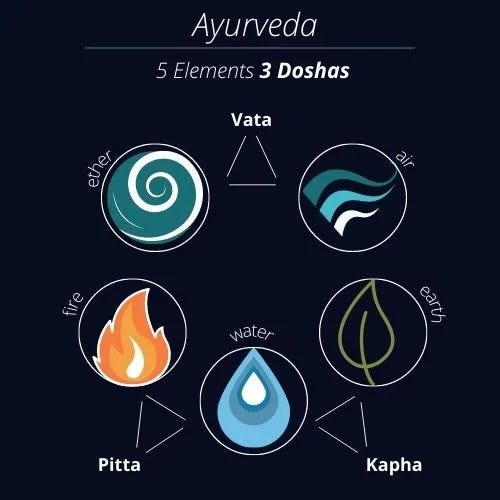As winter progresses, we move from the initial dry and windy cold of early winter to the damp (snowy) cold of mid-late winter/early spring. Millions of people across the southeastern U.S. experienced that (shocking!) shift in the recent record-breaking snowstorms. Seasonal shifts require checking in with our daily diet and habits and recalibrating them as needed to stay in tune with the seasonal changes. Of course, we still need warming foods as the cold continues in many areas. But the nourishing and grounding foods that helped to balance the dry Vata of early winter may not be as beneficial in the damp cold of Kapha season.
What is Kapha?
In Ayurveda, there are five primal elements, or “states of existence”: air, water, fire, earth, and ether (space). Similar to the beliefs of many ancient cultures, Ayurvedic practitioners say these five elements make up everything and describe all the possible interactions of matter and energy. Each element is associated with certain qualities. When these elements manifest in the body, they are condensed into three metabolic forces, or doshas.
There are three doshas in Ayurveda: Vata, Pitta and Kapha. Everyone is a mix of the three doshas, to varying degrees ranging from predominantly one dosha to an equal number of all three (tri-doshic).
The Kapha dosha is a combination of the water and earth elements. Its qualities include cool, heavy, slow, dense, smooth, and stable. These qualities apply to physical and other attributes. For example, cool can relate to the weather, skin temperature, or an easy-going attitude. Heaviness may manifest as a large, grounded constitution (as opposed to the lightness of Vata). If Kapha is in excess, it can mean extra pounds or mental sluggishness.
A person with a strong Kapha constitution has an endomorph body type, with a more stocky build, thick skin, solid musculature, large eyes, thick, soft hair and a tendency to be overweight. Mid- to late winter and spring also embody Kapha characteristics as evidenced by cold, wet weather. Damp cold personifies the cool, heavy, slow, and dense Kapha qualities.
Curious about what your personal dosha is? Click here to find out.
Like increases like
One of the tenets of Ayurveda is "like increases like." For example, if you have a Kapha dosha, or tend to feel cold and are a heavy sleeper, mid-winter to early spring can exacerbate those qualities in you. To counter an excess of Kapha, you'll want to balance your system with food and practices that are warming, drying and stimulating.
Ways to balance the Kapha dosha
One of the simplest ways to balance Kapha is by eating astringent, bitter, and pungent herbs and foods.
Astringent foods dry Kapha and in the words of my teacher, Michael Tierra, "tighten and tone soggy tissues." If your mouth has ever puckered from eating an unripe banana or spinach, you're familiar with the astringent property and flavor. Other astringent foods include beans, acorns, cranberry, and pomegranate.
Bitter and pungent foods reduce and dry Kapha. Bitter foods purify the blood, and stimulate the secretion of bile from the liver and gall bladder as well as peristalsis. (Hands up: how many people drink coffee (a bitter) because it "keeps them regular"?) As with anything, it's possible to have too many bitters, but also highly unlikely in the Western diet. Other bitter foods include artichokes, beets, dark greens like chard, arugula, and dandelion leaves, grapefruit, molasses, bell pepper, olive oil, and parsnip.
Pungent food aids digestion, stimulates circulation, and helps expectoration by breaking up mucus in the gastrointestinal tract and in the lungs. Pungent foods include red pepper, black pepper, ginger, garlic (cooked and raw), mustard, leeks, red chili pepper, sesame seeds and sun-dried tomato. Pungent herbs include some of our favorite cooking herbs: basil, bay, cayenne, oregano, rosemary, sage, thyme, cardamom, clove and cinnamon. They not only taste good, they are superior for helping us digest our food.
Too much Kapha energy can lead to feeling lethargic, heavy, or dull. If you are a Kapha type, or have been indulging in a lot of Kapha energy (drinking hot toddies and Netflix-bingeing, perhaps?), the following practices help counter an excess of "slow and heavy" Kapha:
Movement. Active sports are best, but any type of movement is good. If stuck indoors, perhaps some vigorous mopping or vacuuming (sans Roomba).
Healthy fasting or a light diet. Try kicharee!
Hot baths. A popular Kapha-reduction therapy, hot baths promote sweating, which can relieve Kapha-type colds and flu (those with lots of white mucus - ick!).
And if you didn’t get a chance to try it during Vata season, oleation (oil massage), or abhyanga is still helpful in Kapha season. When used with a more energetic massage, sesame and/or rosemary-infused oil helps to stimulate circulation and lymphatic movement, perking up to the body and mind.
To get the most benefit in Kapha season and maintain a healthy balance heading into spring, put some spice in your life! Try recipes that feature warming and drying herbs and get your body moving to prevent stagnation.
Originally written Nov 2018; edited Feb 2025.








